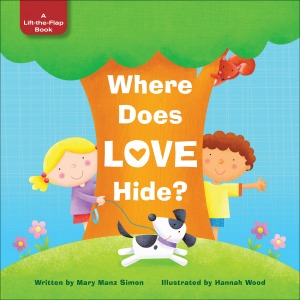In the book Where Does Love Hide? (Tyndale Kids), children are reminded that they not only receive love but have the opportunity to share love. Author Mary Manz Simon talks about working with a team to create an illustrated “peek-a-boo” book, her goals writing the book, and how she gets into the right frame of mind to write for young readers…
Q: WHAT WERE YOUR GOALS WRITING WHERE DOES LOVE HIDE?
 I wanted a young child to begin to grasp the meaning of the emotion of love and to link the word with actions. Here’s some background:
I wanted a young child to begin to grasp the meaning of the emotion of love and to link the word with actions. Here’s some background:
Love is an abstract concept, something very young children cannot grasp. As concrete thinkers, they can only cognitively understand what they physically experience—see, touch, feel, and taste.
In spite of this, even a one-year-old knows the meaning of “No!” Although young children haven’t learned to read words, they’re experts at reading emotions. Because “No” is frequently accompanied by urgency, it’s an easy word to understand!
Around the age of two (that’s the average; some children start at 18 months and some start later), children begin to connect vocabulary with other abstract concepts. A toddler who “helps” unpack groceries doesn’t know that a willingness to serve others comes from a deep gratitude for Jesus’ love for us, as shown on the cross. But the child is beginning to associate the word love with hugs, kisses, and doing kind deeds.
Where Does Love Hide? reaches a very young child at this point in life, when he or she is bridging the gap between behavior and vocabulary. A parent doesn’t say, “Opening the door for me when my arms are loaded with groceries is a sign of love,” but the action reflects the terminology. The everyday examples shown in the book highlight activities in which a toddler could learn to connect loving behavior with the word love.
Q: WHAT INSPIRED YOU TO TAKE THE ABSTRACT CONCEPT OF LOVE INTO SOMETHING CONCRETE FOR YOUNG READERS?
I had three children in under four years. We needed a lot of love floating around our house!
Q: HOW DO YOU GET INTO THE RIGHT FRAME OF MIND TO WRITE FOR THAT AGE GROUP?
 The early years are impressionable, not only for young children, but for parents, too. I will always remember bits and pieces of those sleep-deprived years, so I entered the project with real-life experience. I now have five grandsons. Having earned a doctorate in education provides the developmental framework for living in those early childhood moments.
The early years are impressionable, not only for young children, but for parents, too. I will always remember bits and pieces of those sleep-deprived years, so I entered the project with real-life experience. I now have five grandsons. Having earned a doctorate in education provides the developmental framework for living in those early childhood moments.
Q: WHAT WAS THE PROCESS LIKE WORKING WITH YOUR ILLUSTRATOR?
Any novelty book for young children has more design elements than are used in a traditional format, so there is often a lot of conversation and work with the artistic director, editor, illustrator, and others. All successful publishing projects result from a team effort, but that’s doubly true for a novelty.
For example, in Where Does Love Hide? the flaps are cut differently for each page, but all are large. This makes each flap easy for a young child to grasp and perfectly matches the child-friendly “peek-a-boo” theme of the book.
Because Where Does Love Hide? is intended for a very young child who learns by doing, the physicality of opening flaps engages the reader in a sense beyond the visual. Graphically, illustrations focus on large blocks of bright color. You can see that faces are emphasized; details are minimized. Pages are thick to resist tears by little hands that are just beginning to develop small muscle control.
This is just a glimpse of elements that must fit together perfectly to make a successful novelty book like Where Does Love Hide?
Q: WHAT DO YOU HOPE READERS TAKE AWAY FROM READING WHERE DOES LOVE HIDE?
Signs of love are all around. When you look for God’s love, you see how busy He is. (There is a short Bible memory verse on each page that reflects the content of the book text.)
Q: HOW DOES YOUR FAITH INFLUENCE HOW YOU APPROACH WRITING YOUR STORIES?
My personal mission is to put God-honoring products into the hands of children and their families. I am thrilled God opened the door to create Where Does Love Hide? with the Tyndale team. I love this book and hope others do too!


